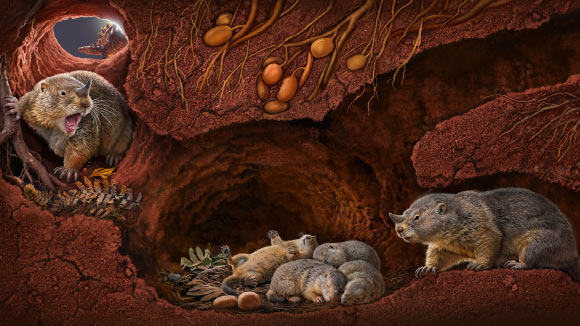The evolution of the modern mammal jaw is more complex than previously thought, according to a new analysis of fossils belonging to two mammaliamorph species: (i) Polistodon chuannanensis, a Middle Jurassic herbivorous tritylodontid with a relatively large body size and a lifestyle that is likely to have been fossorial, and (ii) Camurocondylus lufengensis, the newly-described morganucodontan from the Early Jurassic.
“In mammals, the joint that connects the skull to the lower jaw is made up of two bones: the squamosal and the dentary, the tooth-bearing bone in the lower jaw,” said Dr. Jin Meng, a curator at the American Museum of Natural History and a researcher at City University of New York, and colleagues.
“This structure replaced an older jaw joint found in reptiles, which involved two different bones, the quadrate and the articular.”
“As animals evolved from early mammal-like reptiles into true mammals, several ‘experimental’ versions of this new jaw joint appeared and helped support the pressure of chewing.”
“Eventually, this led to the emergence of a double jaw joint in which the new dentary-squamosal joint carried most of the chewing workload while the reptilian joint continued to function, providing the initial system for airborne sound hearing.”
“Over time, the dentary-squamosal became the only joint, and the articular-quadrate joint transformed into the tiny bones of the mammalian middle ear, a key feature that helps mammals hear.”
But scientists still don’t fully understand how this new jaw joint evolved, mostly because the fossil record from this period is very limited.
“The evolution of the mammalian jaw joint is one of the most intriguing and incomplete chapters in vertebrate history, with key transitions obscured by gaps in the fossil record,” Dr. Meng said.
The researchers used high-resolution computed tomography scanning to look at two fossil specimens from the Institute of Vertebrate Paleontology and Paleoanthropology at the Chinese Academy of Sciences.
One of them is Polistodon chuannanensis, an opossum-sized animal that had a ‘horn’ it likely used for digging.
The second is Camurocondylus lufengensis, the newly-described squirrel-sized animal that lived in the Early Jurassic, between about 174 and 201 million years ago.
The paleontologists found new jaw formations in both ancient animals.
In Polistodon chuannanensis, they identified a uniquely shaped secondary jaw joint between the jugal and the dentary bones, the first discovery of its kind in any four-limbed animal.
And in Camurocondylus lufengensis, they described a simple articular head of the dentary bone that appears to show an evolutionary transition to a form that fits into a socket of an initial new jaw joint.
“These discoveries increase the diversity of jaw joints in mammalian evolution and expand our understanding of the evolutionary sequence of key mammalian characteristics that are critical for understanding how mammals process their food and hear airborne sounds,” the authors concluded.
Their paper was published in September 2025 in the journal Nature.
_____
F. Mao et al. Convergent evolution of diverse jaw joints in mammaliamorphs. Nature, published online September 24, 2025; doi: 10.1038/s41586-025-09572-0








